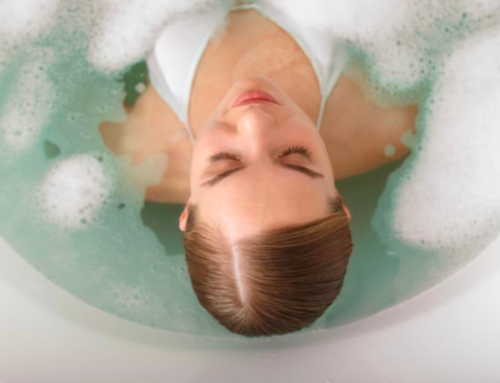Reflexology is a safe and natural way to reduce pain, relieve stress and find deep relaxation. As an ancient holistic healing practice, reflexology has been studied for its psychological and physical well-being, especially in patients fighting chronic diseases or recovery from surgery.
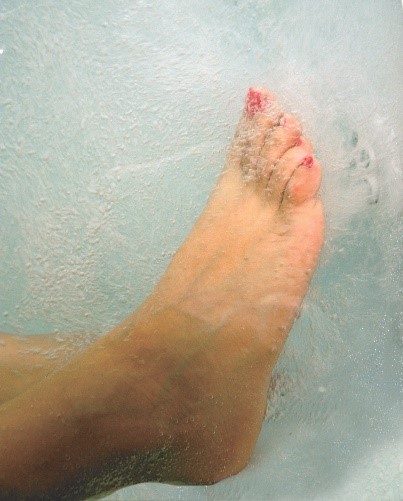 Thanks to therapeutic soaker tubs with hydro massage jets, you’re able to reap the benefits of reflexology and hydrotherapy for feet from the comfort of your home. Therapeutic soaker tubs with massage jets provide the at-home experience of both hydrotherapy and massage.
Thanks to therapeutic soaker tubs with hydro massage jets, you’re able to reap the benefits of reflexology and hydrotherapy for feet from the comfort of your home. Therapeutic soaker tubs with massage jets provide the at-home experience of both hydrotherapy and massage.
What Is Reflexology?
Reflexology is a type of holistic therapy used on the hands and feet to help address a variety of ailments. Reflexologists apply pressure to targeted zones on the soles of the feet and palms of the hands using techniques similar to massage therapy.
As a non-invasive healing method, reflexology offers a natural way to help manage chronic conditions, relieve pain and promote relaxation. It’s considered a safe complementary therapy that can be used in conjunction with other conventional treatments or on its own for stress and pain relief.
How Does Reflexology Work?
To know how reflexology works, we need to understand the nervous system.
The nervous system is the body’s control center for motor movements and sensory reception. It has two main divisions that depend on each other:
- The central nervous system, which contains the brain and spinal cord, is the central operating system of the body.
- The peripheral nervous system sends motor control nerves from the spinal cord to the rest of the body, including the hands and feet.
The peripheral nervous system gathers information from various organs and muscles throughout the body, sending feedback to the brain. It’s also responsible for the body’s autonomic nervous system, which determines whether we’re in a fight-or-flight or rest-and-digest mode.
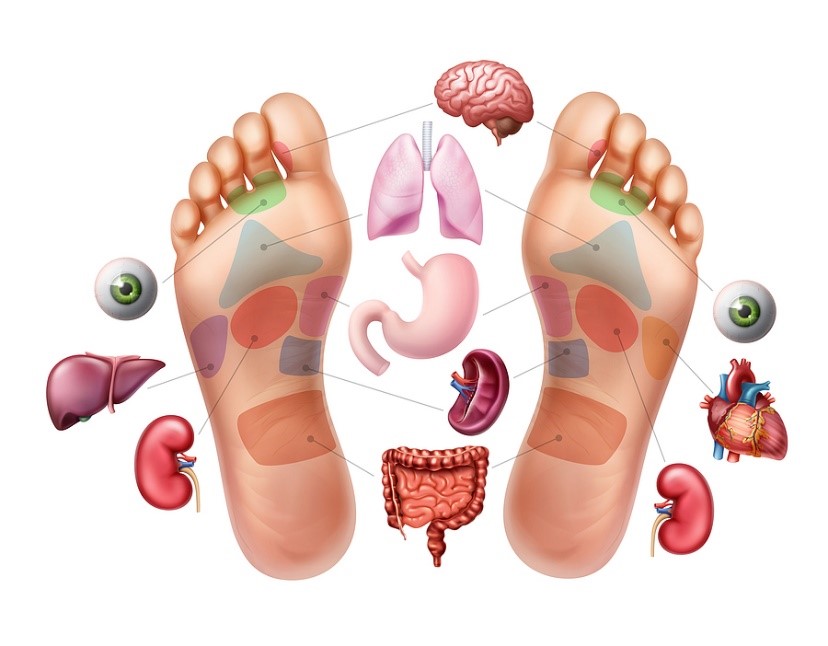 Organs like the heart, stomach, intestines and reproductive system all connect to the central nervous system through their interaction with the peripheral nervous system. Because the peripheral nervous system sends nerves all the way to the feet, these nerves are believed to be connected to organs and muscles elsewhere in the body via reflex circuits.
Organs like the heart, stomach, intestines and reproductive system all connect to the central nervous system through their interaction with the peripheral nervous system. Because the peripheral nervous system sends nerves all the way to the feet, these nerves are believed to be connected to organs and muscles elsewhere in the body via reflex circuits.
Reflexologists map the various organs and muscles onto the foot based on where the corresponding nerve endings are. By applying pressure to specific sections of the foot, practitioners can target the associated part of the body that needs healing.
As the nerve endings in the feet are relaxed, the rest of the body can also experience relaxation.
Ultimately, reflexologists communicate with organs and muscles throughout the body just by manipulating their local connection to the feet.
What Does Reflexology Help With?
Reflexology has been shown to be a safe and beneficial therapy for helping manage stress and pain.
Patients with chronic illnesses tend to experience anxiety, depression and pain, in addition to the main symptoms of the disease. According to the National Institutes of Health, battling a chronic disease makes you more likely to develop mental health conditions, which can also be accompanied by pain.
Patients with the following chronic conditions may benefit from the relaxing experience of therapeutic foot massages:
- Diabetes
- Heart disease
- Multiple sclerosis
- Arthritis
- Pregnancy
- Headaches and migraines
- Cancer and treatment side effects
- Surgery preparation and recovery
Prioritizing your mental and physical health and well-being is critical, and reflexology may be one way for you to find stress- and pain-relief benefits.
What Are the Health Benefits of Reflexology Foot Massage?
Many people who have received reflexology have benefited from therapeutic foot massages. Several studies also support reflexology as a complementary therapy that helps patients with a variety of diseases.
Reflexology provides benefits similar to traditional massage therapy, such as myofascial release of tight connective tissue, relieving muscle tension and reducing stress. Reflexology also has benefits for boosting blood flow, relieving pain and reducing swelling and inflammation.
There are also psychological benefits of reflexology. Foot massage and reflexology are natural ways to boost your mood, reduce anxiety symptoms and promote better sleep.
Below are some of the reasons to consider reflexology and foot massage therapy.
-
Targets Trigger Points
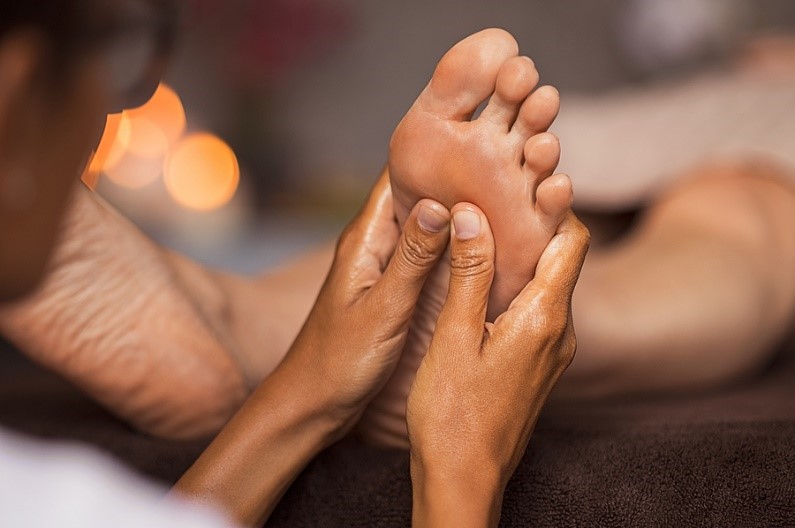 Virtually everyone has experienced muscle injury at some point. With repetitive use, musculoskeletal tissue can undergo stress and tension, leading to localized pain points. Also called trigger points, these areas of tissue or muscle pain not only lead to chronic discomfort but can also restrict range of motion, flexibility and mobility.
Virtually everyone has experienced muscle injury at some point. With repetitive use, musculoskeletal tissue can undergo stress and tension, leading to localized pain points. Also called trigger points, these areas of tissue or muscle pain not only lead to chronic discomfort but can also restrict range of motion, flexibility and mobility.
Deep tissue massage uses the myofascial release technique, which targets trigger points, freeing them from tension and easing the associated symptoms. Like deep tissue massage, reflexology also targets these trigger points on the feet and hands to reduce local and referred pain.
Reflexologists apply pressure to trigger points, which can help loosen deep connective tissues.
The feet contain various trigger points. The arches, heels and balls of the feet are three regions that can benefit from deep tissue massage. By loosening connective tissue in the feet, people can also experience benefits throughout the ankle, calf, and even up into the hip, as trigger point release affects nerves that ascend upward from the feet.
-
Boosts Blood Circulation
Massage and touch therapy have important benefits for boosting blood flow and lymph fluid circulation. Blood delivers vital oxygen and nutrients to tissues and organs throughout your body. Without proper blood circulation, your tissues and organs don’t function as effectively as they should, which can reduce your well-being over time.
Some of the effects of poor blood circulation include:
- Tingling in hands and feet
- Numbness in fingers and toes
- Throbbing pain
- “Pins and needles”
- Muscle cramping
- Ankle swelling (edema)
Self-massage, professional massage therapy or reflexology can all help boost blood flow in the feet, which may also improve blood flow in associated areas. A 2006 research study looked at how blood flow changes occurred in patients who received reflexology applied to the soles of their feet.
According to the research, physical pressure applied to the feet was associated with increased thermal activity in five major organ areas:
- Lung
- Liver
- Stomach
- Pancreas
- Small intestine
Increasing circulation in the feet and lower legs is especially important for people who are sedentary or unable to engage in regular physical activity due to health and mobility restrictions. Foot massages or reflexology can help compensate for inactivity by physically manipulating soft tissue and stimulating blood circulation.
A 10-minute daily self-massage can give your feet a much-needed blood flow boost and help reduce symptoms of poor circulation.
-
Helps Relieve Pain Naturally
An estimated 20% of American adults suffer from chronic pain. For many people, chronic pain significantly interferes with their daily activities, leaving them searching for ways to relieve their symptoms.
Natural pain relief is any method that helps to reduce the effects of chronic pain without the use of pharmaceuticals. Many of these therapies are safe, non-invasive and don’t present a serious risk of side effects. Reflexology is one such natural therapy that may help you reduce various types of chronic pain symptoms.
A 2014 study published in the journal Evidence-Based Complementary and Alternative Medicine examined the benefits of foot massage for diabetics. Researchers found that diabetic neuropathy patients treated with reflexology and painkillers experienced better pain reduction than patients who were treated with painkillers alone.
There are many theories as to why reflexology helps reduce pain. One proposed explanation is that reflexology sends your nervous system into a state of relaxation. While relaxed, we’re less likely to experience the sensation of pain due to reduced stress and increased mood. This effect may be especially important for people managing painful chronic diseases, like multiple sclerosis or diabetes.
Another explanation for the effects of reflexology on chronic pain is that trained reflexologists are able to target tension throughout the body by stimulating corresponding parts of the foot. In particular, manipulating certain areas of the foot appears to have benefits for treating painful conditions like headaches and migraines, as well as back and neck pain.
-
Relaxes Muscle Tension
One of the most immediate benefits of touch therapy is relief from muscle tension. Massage therapy, reflexology and acupressure are all direct ways to help ease muscle soreness.
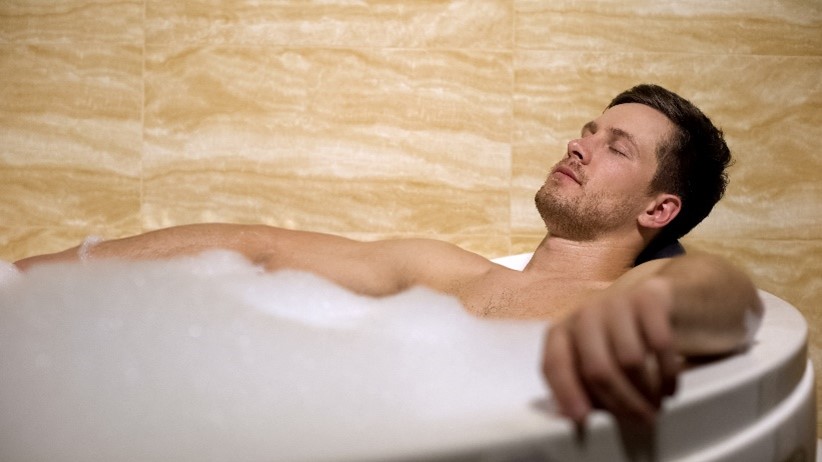 Muscle tension can occur for many reasons. Holding physical tension in the body constricts muscles, making it harder for you to relax. Repetitive motion injuries and recovering from trauma, such as surgery, can all lead to muscle tension. Additionally, being physically inactive can also constrict muscles, as well as the protective layer of connective tissue, called fascia, that covers muscles and organs.
Muscle tension can occur for many reasons. Holding physical tension in the body constricts muscles, making it harder for you to relax. Repetitive motion injuries and recovering from trauma, such as surgery, can all lead to muscle tension. Additionally, being physically inactive can also constrict muscles, as well as the protective layer of connective tissue, called fascia, that covers muscles and organs.
Whatever the cause, chronic muscle tension can affect quality of life if it becomes extremely painful over time. Finding safe and natural ways to relieve muscle tension can help you feel better and improve mobility.
While massage therapy is a well-known way to directly target localized muscle tension, reflexology may be a better alternative for people who prefer a less invasive form of touch therapy.
With reflexology, a trained practitioner gently manipulates your feet in a systematic way that corresponds to the other areas of your body experiencing tension. During a reflexology session, you can tell your practitioner which areas of your body are tense, such as your low back, shoulders or neck. The reflexologist will target the associated areas of the feet, helping you to relax and release tension in those areas.
-
Reduces Inflammation
Inflammation is your body’s natural response to an imbalance, whether it’s an infection, illness or stress. While inflammation is your body’s way of temporarily protecting your health, prolonged inflammation can lead to chronic illnesses. Finding safe and natural ways to reduce stress, tension and inflammation is a positive preventive health step to take.
Reduced inflammation in the body is one of the potential secondary benefits of foot massage reflexology.
Touch therapy helps to stimulate blood flow in the body, relax tight muscles and reduce mental and physical stress. When the body is put into a natural state of relaxation, it’s less likely to produce an inflammatory response, reducing the harmful effects of this chronic reaction.
Many people with inflammatory diseases, such as arthritis or inflammatory bowel disease, can benefit from natural therapies because of their effect on pain, tension and swelling. Additionally, pregnant women who experience edema (ankle swelling) may also benefit from reflexology for swollen feet to help promote circulation throughout the calves and ankles.
-
Promotes Better Sleep
Sleep quality is vital to our long-term health. During sleep, our body restores and repairs itself and eliminates toxins, while the brain consolidates memories for sharper thinking and learning. When we don’t get enough high-quality sleep, we’re at risk of developing mood disorders, heart disease and many other conditions.
With roughly one-third of the U.S. population reporting they don’t get enough sleep, it’s essential to find natural ways to promote better sleep quality.
Because reflexology and foot massages provide a relaxing experience, they can also counter some of the factors that lead to sleep disturbances. Many people have a hard time falling and staying asleep because they feel stressed, anxious or worried. Undergoing natural therapies that help to reduce stress can also promote deeper sleep.
Experts say the benefits of foot massage before bed can provide a relaxing experience to help you sleep better.
Additionally, foot massages and reflexology may also address sources of pain that can disrupt sleep. Chronic pain can significantly affect our sleep quality and make it uncomfortable to lie down for extended periods. Reflexology may be an effective way to both reduce stress and alleviate pain associated with sleep disruptions.
-
May Ease Anxiety
Each year, millions of Americans experience acute and chronic anxiety, and many people struggle with this condition in silence. While it can be difficult to overcome, there are many natural ways to address the underlying causes of anxiety. Having safe and accessible tools to restore mental and emotional well-being is critical for adults managing anxiety.
Because natural therapeutic practices like massage and reflexology help people to relax, they’re also believed to help people manage anxiety symptoms. Reflexology, in particular, may be beneficial for people dealing with anxiety as the result of other health diagnoses or treatments.
A handful of studies have shown the benefits of reflexology for anxiety. One clinical trial compared the effects of reflexology vs. basic foot rubs in patients recovering from heart surgery. The researchers found that patients who received reflexology following surgery reported significantly lower levels of anxiety.
Another clinical trial looked at the benefits of reflexology for cancer patients. After undergoing a 30-minute reflexology session to both feet, the cancer patients reported a significant decrease in anxiety. The results also showed that breast cancer patients, in particular, also experienced reduced pain after their reflexology treatment.
Findings like these suggest not only that reflexology could be an important natural and complementary therapy for managing chronic disease but that it may also offer patients a valuable self-care tool.
Undergoing cancer treatment, surgery and any other serious health intervention can cause patients to experience anxiety. By having ways to practice self-care at home, patients can help improve their emotional and mental well-being.
How Hydrotherapy Jets Deliver Reflexology Foot Massage
Hydrotherapy is the use of a hot water bath at home for therapeutic sessions. Immersing yourself in a warm or hot bath daily has many benefits for physical and mental well-being. Specialized hydrotherapy tubs with whirlpool jets, air jets and hydro massage jets take bathing to another level.
By delivering soothing massaging technology, hydro massage jets can help you achieve the benefits of both massage therapy and hydrotherapy in one.
With a hydro massage bathtub, you’re able to experience the benefits of a reflexology foot massage from the comfort of your home. With the proper jet design and placement, you can position hydro massage jets on the soles of the feet and find soothing relief.
Jet Design
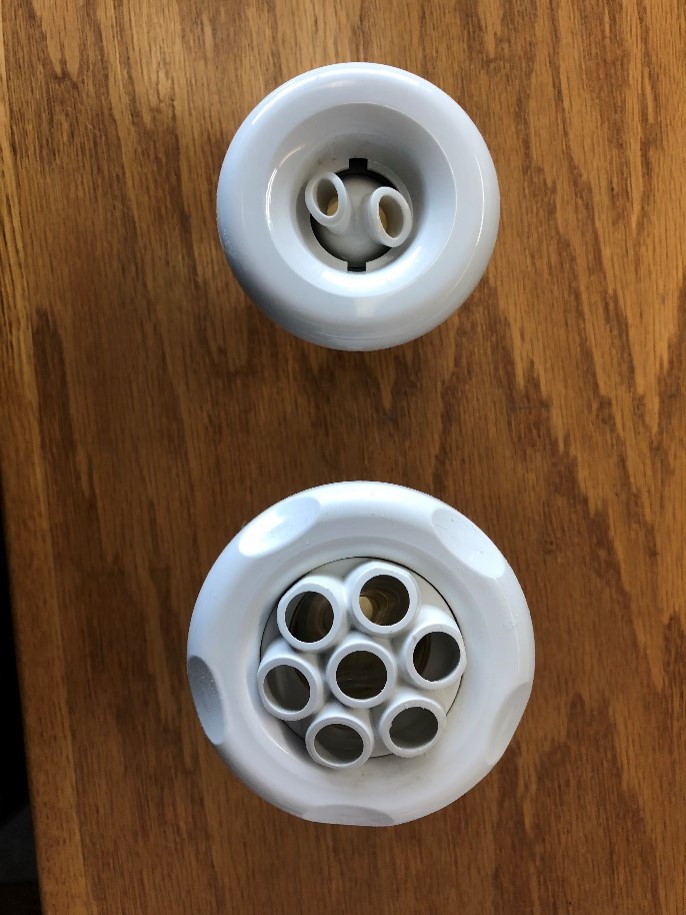 Different bathtub types provide massage technology through various jet designs. You may be familiar with jetted soaker tubs that have small jets that deliver a single stream of water. Hydro massage soaker tubs are designed with jets that deliver multiple streams of water for a more impactful massage sensation.
Different bathtub types provide massage technology through various jet designs. You may be familiar with jetted soaker tubs that have small jets that deliver a single stream of water. Hydro massage soaker tubs are designed with jets that deliver multiple streams of water for a more impactful massage sensation.
Hydro massage soaker tubs have two jet designs to choose from that can help you achieve a soothing foot massage:
- Ultra Massage Jets: Delivering two streams of water, the Ultra Massage Jet option covers a three-inch target area. With a wider circle, you can position your foot so that the Ultimate Massage Jet targets larger zones of the foot, such as those that correspond to the heart, lungs, stomach or intestines.
- Sole Soother Jets: The Hydro Massage Therapeutic Sole Soother Jet gives you more precise control over your at-home foot massage. With seven separate jet streams, the Sole Soother Jets allow you to position your foot so that each stream targets more reflexology trigger points at once with precision.
The Ultra Massage Jets are available in all Hydro Massage Series whirlpool tubs, while the Sole Soother Jets are available in the Platinum Series hydro massage tubs.
Jet Placement
In addition to jet design, you also need a hydrotherapy soaker tub with the correct jet placement. Jets need to be positioned so that they target the soles of your feet and deliver an effective therapeutic foot massage.
In traditional jetted soaker tubs, jet placement doesn’t take into account reflexology trigger points. Conventional jetted tubs have jets placed in such a way that they only target the toes rather than the soles of the feet.
Hydro Massage whirlpool tubs are designed to target the soles of the feet so you can perform self-massage at home. With strong and pulsating streams of water, Hydro Massage jets help work on common trigger points throughout the arches and along the plantar regions.
Get All the Benefits of Reflexology at Home With Hydrotherapy Massage Bathtubs
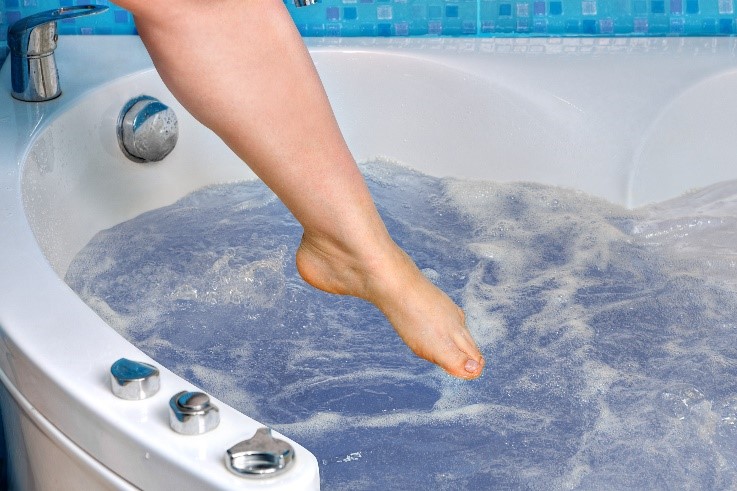 Get the benefits of reflexology and therapeutic foot massages at home with hydro massage soaker tubs. Customize your whirlpool bathtub with Ultra Massage or Sole Soother jets. With several bath styles, massage options and accessories to choose from, you can design your ideal sanctuary at home.
Get the benefits of reflexology and therapeutic foot massages at home with hydro massage soaker tubs. Customize your whirlpool bathtub with Ultra Massage or Sole Soother jets. With several bath styles, massage options and accessories to choose from, you can design your ideal sanctuary at home.
From reducing stress to relieving pain to healing damaged tissues, there are many essential benefits of hydro massage therapy. Find your perfect soaker tub today and experience a blissful and relaxing hydrotherapy massage.
*Hydrotherapy plans for treatment of health conditions should be reviewed by a healthcare professional. The information contained on this site is not a substitute for professional medical advice, diagnosis, or treatment. Hydro Massage Products makes no claims for treating, healing, or curing any health conditions. All information on this site is for general information and educational purposes only. Hydro Massage Products encourages you to confirm any information obtained from or through this web site, regarding health claims from customers or dimensions of bathtubs.
Sources:
- https://www.mayoclinic.org/healthy-lifestyle/consumer-health/expert-answers/what-is-reflexology/faq-20058139
- https://www.nimh.nih.gov/health/publications/chronic-illness-mental-health/
- https://www.aafp.org/afp/2002/0215/p653.html
- https://www.takingcharge.csh.umn.edu/explore-healing-practices/massage-therapy/how-does-massage-work
- https://jamaicahospital.org/newsletter/signs-of-poor-circulation-you-should-not-ignore/
- https://reflexology-usa.org/wp-content/uploads/Piquemal_Article.pdf
- https://www.cdc.gov/mmwr/volumes/67/wr/mm6736a2.htm
- https://pubmed.ncbi.nlm.nih.gov/24527055/
- https://pubmed.ncbi.nlm.nih.gov/26220257/
- https://www.takingcharge.csh.umn.edu/explore-healing-practices/reflexology/what-does-research-say-about-refloxology
- https://www.foot.com/7-benefits-foot-massage-reflexology/
- https://www.arthritis.org/health-wellness/treatment/complementary-therapies/natural-therapies/benefits-of-massage
- https://www.ncbi.nlm.nih.gov/pmc/articles/PMC5449130/#:~:text=In%20otherwise%20healthy%20adults%2C%20short,%2C%20memory%2C%20and%20performance%20deficits.
- https://www.cdc.gov/sleep/data_statistics.html
- https://adaa.org/understanding-anxiety/facts-statistics
- https://www.sciencedirect.com/science/article/abs/pii/S1744388113000753
- https://pubmed.ncbi.nlm.nih.gov/10660924/

